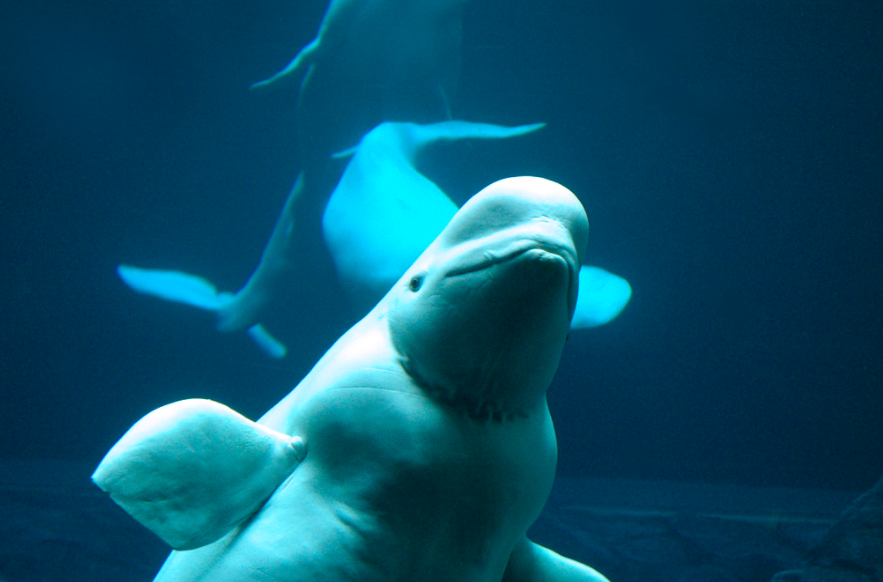
3 Months and Counting: Pipeline Leaks Natural Gas Into Alaska’s Cook Inlet

Cook Inlet is a designated critical habitat for beluga whales. Photo credit: Flickr
For more than three months, an underwater pipeline has been spewing hundreds of thousands of cubic feet of processed natural gas per day in Alaska’s Cook Inlet, possibly threatening critically endangered beluga whales, fish and other wildlife.
The 8-inch pipeline, owned and operated by Hilcorp Alaska, is leaking more than 210,000 cubic feet of gas per day. The gas is 99 percent methane and provides fuel for four platforms in Cook Inlet.
250 Protestors Demand Enbridge Pipeline Shutdown Over Fears of Great Lakes Oil Spill https://t.co/eLpahRacT2 (@ecowatch)
— Sierra Club (@SierraClub) March 14, 2017
A notice from the U.S. Pipeline and Hazardous Materials Safety Administration (PHMSA) revealed that Hilcorp knew about the leak as early as December but did not report the leak until Feb. 7 after a helicopter spotted gas bubbling to the surface of the water.
PHMSA said that the natural gas discharge could pose a risk to public safety, the environment and marine mammals and has given Hilcorp until May 1 to permanently repair the line or shut it down.
But conservation groups warn that waiting until May could allow the release of another 16 million cubic feet of gas. Seven groups have submitted a letter to the Trump administration urging for an immediate shutdown of the 52-year-old pipeline.
“This dangerous leak could stop immediately if regulators did their job and shut down this rickety old pipeline,” said Miyoko Sakashita, the Center for Biological Diversity oceans program director. “We’re disgusted with the Trump administration’s lack of concern about this ongoing disaster. Every day the leak continues, this pipeline spews more pollution into Cook Inlet and threatens endangered belugas and other wildlife.”
The letter was signed by the Center for Biological Diversity, Friends of the Earth, Natural Resources Defense Council, Defenders of Wildlife, Resisting Environmental Destruction on Indigenous Lands, Greenpeace and the Eyak Preservation Council.
Hilcorp contends that Cook Inlet’s heavy ice cover and strong tides has made it too risky for divers to immediately fix the problem and is waiting until at least late March or April for the ice to clear.
The ice cover has also made it impossible to survey the leak’s risks to environmental and wildlife. But scientists have already warned that the impact could be disastrous.
“There are three potential impacts that we worry about,” Chris Sabine, a chemical oceanographer with the National Oceanic and Atmospheric Administration (NOAA), detailed to InsideClimate News.
First, methane exposure could be harmful to fish, potentially disturbing its main functional systems—respiration, nervous system, blood formation, enzyme activity and others. Secondly, Sabine explained that bacteria metabolizing the methane-saturated water could produce additional carbon dioxide and deplete oxygen levels in the water, creating a hypoxic zone. Lastly, this extra CO2 can cause the water to become more acidic, which can cause shells of some animals to weaken.
Sadie Wright, a NOAA marine mammals specialist, added that the hypoxic zone could impact the food supply for Cook Inlet’s estimated 340 belugas.
The the noise coming from the leak could also be a “potential stressor,” she said, as excessive noise can cause belugas to abandon their habitat.
“We don’t have any idea how loud the leak might be,” said Wright.
Not much is known about what is happening under Cook Inlet’s icy waters. State regulators only issued a preliminary approval of Hilcorp’s sampling and environmental monitoring plan on Tuesday.
So far, aerial surveys of the leaking gas field has not uncovered any injured birds or marine mammals, including beluga whales, state officials reported.
To slow the leak, the company lowered pressure in the affected line on March 4, estimating that leak was reduced to 210,000 to 310,000 cubic feet of gas daily. It again lowered the pressure on Monday and estimated the line is leaking 193,000 to 215,000 cubic feet daily.
As for why Hilcorp hasn’t just shut down its line, the company said that an oil spill could occur because the line was once used to carry oil.
Shutting down the pipeline would risk it “taking in water, freezing and potentially rupturing,” Lori Nelson, external affairs manager at Hilcorp Alaska, explained last month to Alaska Dispatch News. Nelson also said that the line needs to be kept pressurized or else it could fill with water, allowing residual crude oil to escape from what was previously used as a crude oil pipeline.
The Center for Biological Diversity has sent a notice of intent to sue Hilcorp under the Clean Water Act and the Clean Air Act. Homer, Alaska nonprofit Cook Inletkeeper has sent a similar notice to sue.
“If Hilcorp cannot or will not stop polluting our public resources, then it should have no right to operate in our waters in the first place,” Cook Inletkeeper executive director Bob Shavelson wrote in a blog post. “Hilcorp has put forth various excuses why it cannot shut down the leaking pipeline in Cook Inlet’s icy conditions—including that water would infiltrate the gas line and other reasons—but the fact remains Hilcorp simply wants to maintain production and profits without interruption.”

 233k
233k  41k
41k  Subscribe
Subscribe 